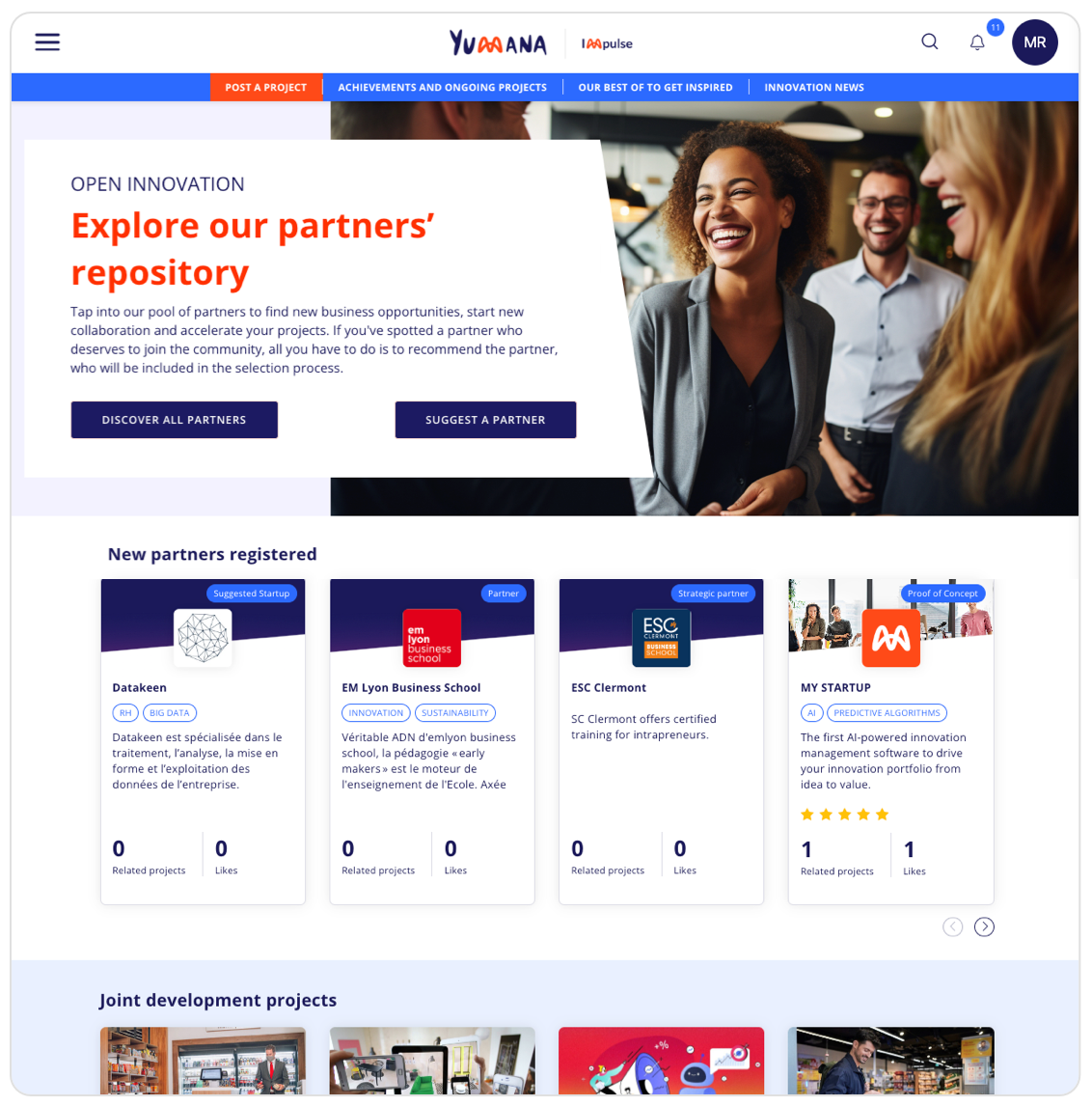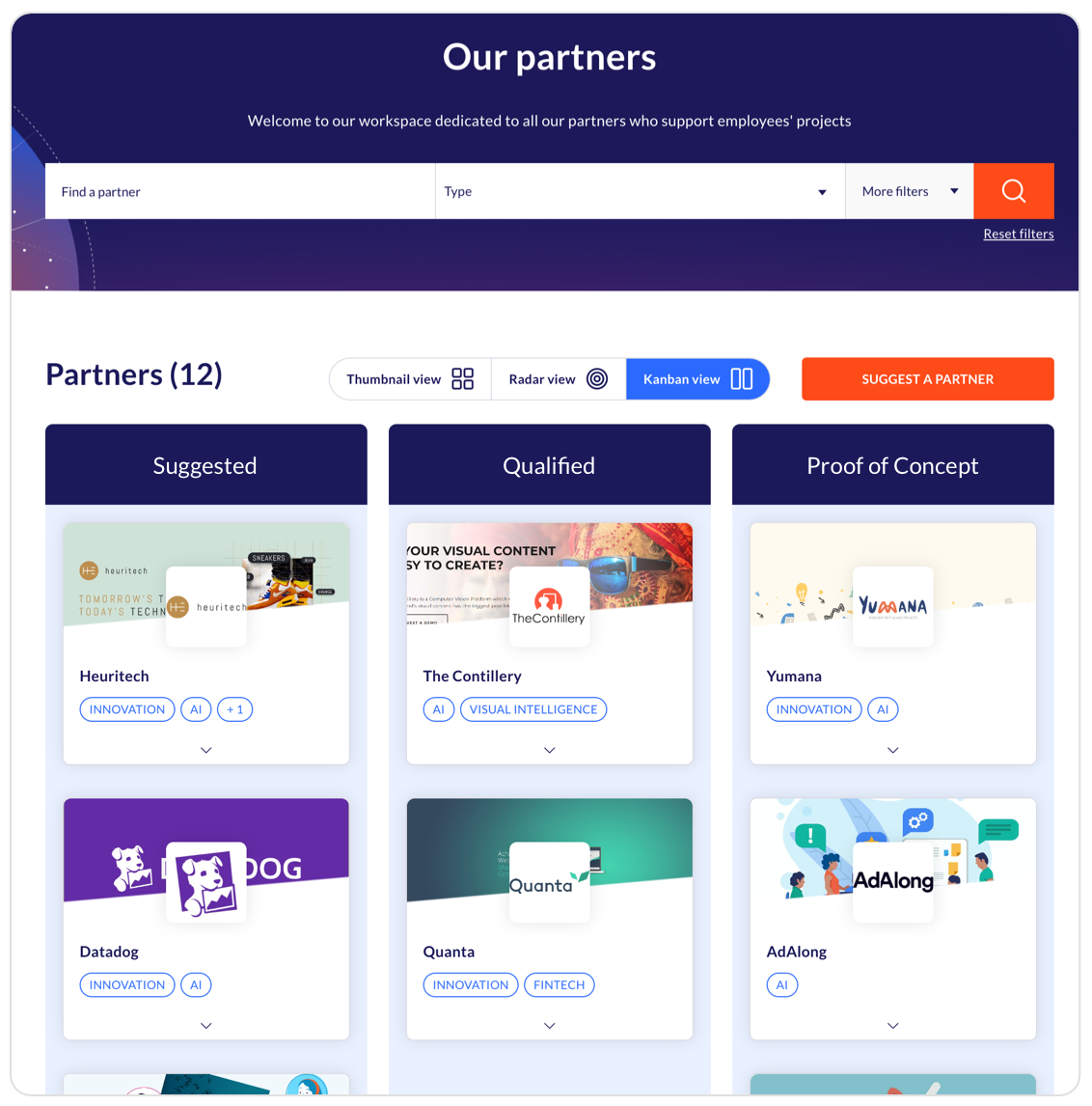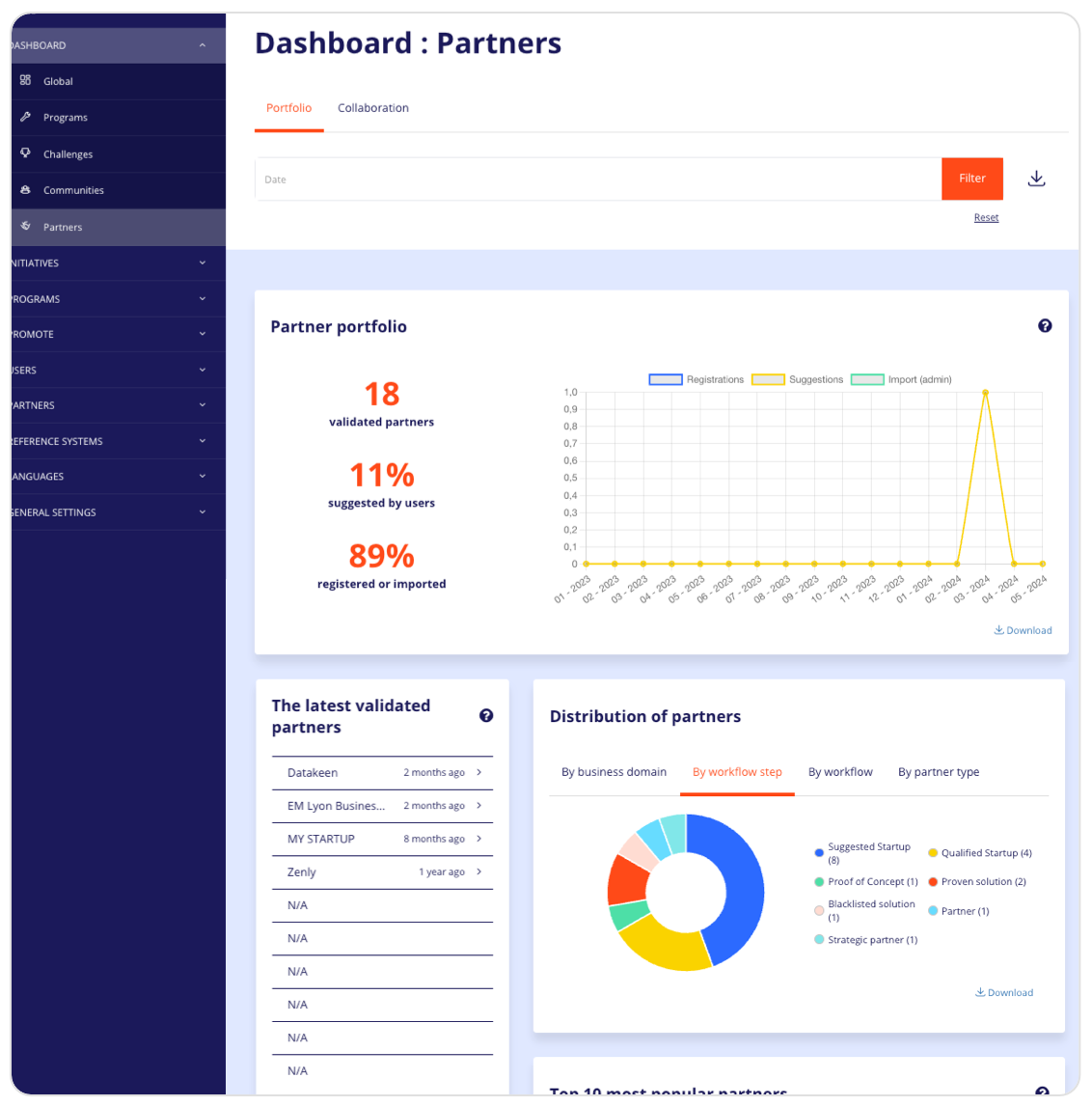- Innovation management
- Open Innovation
INNOVATION MANAGEMENT
Open Innovation
Do you want to turn your external communities into committed players in your growth?
Put your partners at the heart of your strategy with the Yumana platform. Start-ups, academics, incubators... develop a network of qualified partners and work together effectively to accelerate your innovation projects.
Definition and objectives of open innovation

What is open innovation and why embrace it?
Open innovation is a collaborative approach aimed at integrating external actors into your innovation strategy. Faced with a need for specific resources or skills that are not available within your organization, you can broaden your horizons by calling on partners (start-ups, universities, incubators) to speed up your innovation process.
More broadly, launching an idea campaign or a competition open to the public can also be called 'open innovation', but this type of action is often only the first step in an overall open innovation strategy.
The objectives of open innovation are many: to gain access to skills or technology not available within your company, to test new solutions, to broaden your pool of partners, etc.
Launching an open innovation strategy
How to succeed in open innovation?
Step by step

The keys to a successful open innovation program
Open innovation makes it easier to involve external stakeholders in your innovation strategy. To successfully implement your open innovation approach, you need to think about how you want to integrate your partners into your organization.
There are several elements you need to master to ensure the success of your approach:
- Identify where you want to collaborate with partners: to ensure the success of your approach, identify in advance the areas in which you want to involve your partners. Prioritize those areas where your staff will easily understand the need for an external actor.
- Raise open innovation awareness among your teams: limit the risk of "not invented here" by raising awareness upfront among teams likely to collaborate with external actors.
- Define your approach: identify the stakeholders, framework and governance of your open innovation program. Communicate transparently about the rules to be followed, both internally and externally.
- Choose the right tool: not all innovation management softwares can be used to adopt an open innovation approach. To centralize your innovation management and build bridges with your internal innovation projects, choose a platform like Yumana that can meet your challenges and accurately monitor the ROI of your program.

Step 1: Design your open innovation program
This first stage is crucial: it will determine how you will succeed in open innovation.
Before you start your program, you need to identify the following elements:
-
To successfully involve external stakeholders in your internal strategic issues, three elements are essential:
- Know in advance what you expect from open innovation, so that you can easily identify the areas in which you want to involve your partners;
- Have a clear vision of what you consider to be a successful collaboration;
- Share this vision and your objectives internally and externally to ensure that all your stakeholders understand and take ownership of them.
-
Define in advance the formal and informal rules that will govern your open innovation approach:
- Scouting and identification of potential partners;
- Governance and legal framework to facilitate and accelerate the start of collaboration between corporates and startups;
- Partner selection stages and criteria shared with all stakeholders;
- Feedback sharing within the organization on the collaborations established.
These governance mechanisms need to be defined and shared with your partners.
To ensure that the various collaborative projects get off the ground, remember that open innovation remains a collaborative and non-delegative approach: your partners innovate with you, not exclusively for you.
-
Integrating new players into your approach can turn your usual working methods on their head:
- Existing processes on both sides are often very different. To avoid imposing rigid processes on your partners, you need to work together on the different stages of your collaboration.
- Centralizing the management of your partners means changing practices within your organization. To facilitate the adoption of this new approach, stay flexible: systematize feedback and evolve your operating model towards a truly collaborative approach.
-
Applications, new partners, ongoing collaborations, POCs, completed projects... These are all important metrics to track in order to monitor your open innovation program. To measure its success, define the key indicators in advance. Share them internally and with your partners, and easily identify the most promising collaborations and the obstacles that need to be overcome.

Step 2: Source the right partners at the right time
You've defined the key elements of your open innovation program. Now it's time to launch your program and source partners in line with your strategy.
How do you find the right partners at the right time?
-
Trust your teams! Most of your employees already work with a number of partners. To identify the ideal partners, ask your employees to list the players they work with. With Yumana, you can go one step further and give your teams the opportunity to share their feedback on previous collaborations.
-
There are a number of databases on the market that you can use to search and identify the players that can create synergies for your business. Their weakness? Although they are comprehensive, they require at least the involvement of a technical team to integrate the data into your CRM.
Yumana's solution is designed to simplify your experience, allowing you to benefit from the richness of an external database directly on your platform, without requiring the intervention of your teams.
-
Want to broaden your partner base on a specific topic? Organize a challenge to engage external communities on the topic of your choice! Environmental or social innovation, creating products with disruptive technologies, solving business challenges... There are many topics on which you can enlist the help of business partners.
To facilitate the management of challenges and the integration of winners into your partner repository, Yumana offers you an all-in-one solution designed to manage your partner community from start to finish.

Step 3: Evaluate and select partners in line with your strategy
You now have a substantial pool of potential partners. Before proposing them to your whole company, a selection phase is necessary.
There are several ways to find out if they are in line with your objectives:
-
To get a more complete picture of what your potential partners can bring to the table, prioritize first-hand feedback from your employees. Encourage stakeholders who have worked with particular partners to give their opinion:
- Did the collaboration go well?
- Did it bear fruit?
- Is the partner trustworthy?
Then encourage your teams to say whether they would recommend the organizations they have worked with, and get an overall view of the quality of your dealflow.
-
Are the potential partners relevant to your organization? Do they meet your business needs? Will working with them add real value to your teams? Yumana allows you to create personalized scorecards to help you evaluate your deal flow. Your partner repository managers will need to complete these to select the most relevant candidates for your organization.
-
To assess the relevance of certain potential partners, it is sometimes necessary to involve business experts. With the Yumana platform, you can invite your community of experts to provide feedback on the relevance of a potential partner with just one click. They can then directly evaluate the potential partner against fully customizable criteria that you select or your experts recommend.

Step 4: Start working with external partners
You have selected the partners that meet your company's needs. Before you start innovating together, we strongly advise you to establish a framework that is profitable for both you and your partners.
-
Intellectual property rights, contractual obligations and technology transfer are important points to consider. Don't underestimate the importance of defining a common framework from which both you and your partners can benefit, in order to avoid obstacles in the future.
In addition to the legal framework, think about defining the different stages of your collaboration (contractualization, initial testing, approved solution, etc.). By defining this operational process together, you will maximize your chances of establishing a mutually beneficial collaboration. To facilitate this scoping phase, Yumana provides you with a number of dedicated tools:
- A secure space to store your confidential documents, visible only to authorized personnel;
- A fully customizable workflow to model the various milestones of your partner relationship within your platform.
-
Once the framework is in place, it's time to launch your first collaboration. Its prime objective? To innovate by encouraging knowledge sharing that benefits both you and your partners. This collaboration can take many forms:
- Ideation challenges
- Joint R&D projects
- Co-development
- Technology transfer, etc.
With the Yumana Suite, you benefit from a range of tools to ensure fruitful collaboration with your partners.
Your employees can directly involve the relevant partners in their projects. External stakeholders are included in the collaborative workspace and have access to all the information and tools they need to collaborate successfully.

Step 5: Accelerate the impact of open innovation in your organization
Your employees have started their first collaborations with the partners in your repository. How can you increase the impact of open innovation in your organization tenfold? What steps do you need to take to achieve this?
-
Before validating a concept, it is necessary to test its relevance and impact on your organization. Collaborations with external partners typically go through a POC (proof of concept) phase, which is dedicated to assessing the added value of a project under development. To ensure the success of a POC, the Yumana Suite allows you to track its progress and integrate milestones, also known as stage gates, which act as checkpoints as the project progresses. This means that you can easily monitor the progress of projects in collaboration with external stakeholders and intervene with the various teams when necessary.
-
Do your teams have projects they want to launch but are unable to do so due to a lack of internal resources? Encourage them to collaborate with your partners! Make your platform the central point of exchange between your organization and your external ecosystem. By encouraging your teams to use your platform whenever they're looking for an innovative solution from outside your company, you can centralize all collaborations and more easily manage the results of your open innovation strategy. With Yumana, you can track the progress of collaborations between your units and your partners. At a glance, you can identify and reward the most dynamic entities. In this way, you can motivate the rest of your organization to adopt open innovation as a performance accelerator.
Customer testimonials
They succeeded in open innovation with Yumana

 The platform increases transversality within the Group, fostering communication between facilities and corporate teams.
The platform increases transversality within the Group, fostering communication between facilities and corporate teams.
The Group is currently in a phase of pronounced growth and Innovalto helps us conserve and even reinforce our agility.
Ever since its presentation to our facilities’ directors, the Yumana innovation management software has won them over thanks to its intuitive and user-friendly interface. Marie-Pascale Chague,
Marie-Pascale Chague,
Innovation and Transformation Director,
Vivalto Santé
Customer Success Stories
Draw inspiration from our customers to launch
your open innovation strategy!
FAQ

All you need to know to succeed
in open innovation
-
To ensure the success of your open innovation program, you need to master four key elements:
- The partnership framework: to avoid intellectual property problems, it is essential to define a legal framework and to be aware of the different terms and conditions of each partnership you enter into. This will allow you to move forward with confidence with your partners.
- Partnership stages: open innovation is complex because it forces you to integrate external players into your internal processes. By defining a common process with your partners, you will facilitate exchanges and fruitful collaborations.
- Transparency: opt for transparent communication with all your stakeholders: partners, employees, COMEX, etc. to facilitate exchanges and external relations.
- Tools: without tools, it will be impossible to centralize your entire portfolio of partners. Choose a tool that can build bridges between your different stakeholders to boost collaboration.
-
Although it is possible to work with external actors without the appropriate tools (for example, in your relationships with suppliers), you will not be able to launch an open innovation initiative without a platform:
- Dealflow management: to reference a maximum of partners aligned with your strategic challenges, you need to correctly manage your end-to-end dealflow. This means being able to evaluate, select and reference the partners you want to work with. Without a platform, this management becomes chaotic and inefficient, increasing the risk of missing out on key partners.
- Centralize information: a dedicated platform allows all relevant information to be centralized in a single environment, resulting in significant productivity gains for the business. Without a tool, data on partners, projects and collaborations is scattered across multiple systems and formats. This makes information management extremely complex, increasing the risk of information loss and redundancy in the actions you take with your partners.
- Facilitate collaboration: open innovation tools are designed to facilitate communication and collaboration between your internal teams and your external partners. Without these tools, coordinating efforts, sharing documents, monitoring project progress and resolving issues in real time becomes much more difficult, slowing down the innovation process.
- Track and measure results: an open innovation platform allows you to track the progress of collaborations, measure results and analyze performance. Without this tool, you won't be able to effectively manage your open innovation strategy, learn from past projects and adjust your actions to maximize the future impact of open innovation on your business.
-
There are three general types of open innovation. Depending on your strategy, they may or may not apply to you. Here's what you need to know about these three models:
- “Outside-in” open innovation: this is the best known open innovation practice, especially for large companies. Outside-in innovation is when a company integrates external technologies, products or services into its value chain to encourage the emergence of internal innovation.
- “Inside out” open innovation: this is when a company offers innovative products, services or technologies to the market with the aim of encouraging their development outside the company. An example is open source, where companies make their technology available to external actors to encourage the creation of innovative products.
- “Coupled” open innovation: coupled open innovation is when a company practices both types of innovation described above. It may share innovative solutions externally, while at the same time integrating new services, technologies or products developed by external actors into its value chain.
-
Open innovation is innovation that involves external stakeholders in its processes. Closed innovation involves only the company's internal stakeholders. Why choose open over closed innovation?
- You increase the number of stakeholders who can provide you with innovative solutions: although your teams are experts in your key issues, external partners can take a fresh look at the solutions you consider innovative. As well as providing their expertise, they can also help you take a step back and rethink your market positioning.
- You reduce your costs: closed innovation is based on the belief that innovation must come from internal resources. But to do this, you need to recruit experts, which is expensive for your company. Open innovation, on the other hand, allows you to call on experts when you need them, significantly reducing the cost of innovation for your company.
- You share the risks: by working with external partners, you can spread the costs and risks associated with research and development. This pooling of resources not only reduces the financial burden on each participant, but also diversifies the risks by spreading them across multiple projects and partners. In this way, even if one project is not successful, the losses are offset by the potential gains from other initiatives.
Our innovation management solutions
Discover all our innovation management solutions
Innovation challenge
Launch calls for ideas campaigns to quickly identify concrete and innovative solutions to deploy.
Find out moreCorporate innovation
Acculturate your teams to innovation to design and improve your products and services
Find out moreIntrapreneurship
Reveal and develop talents’ new skills to explore new business opportunities
Find out moreResources
Our resources to help you
succeed in open innovation

Ready to launch your open innovation strategy?
Don't wait any longer, contact our experts today and join the Yumana community!


Want more information about our solution? Let's talk! I'd like to learn more about your innovation challenges.
